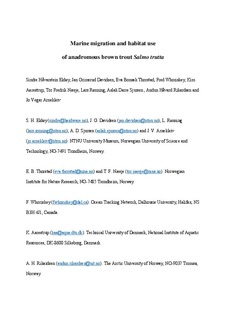| dc.contributor.author | Eldøy, Sindre Håvarstein | |
| dc.contributor.author | Davidsen, Jan Grimsrud | |
| dc.contributor.author | Thorstad, Eva Bonsak | |
| dc.contributor.author | Whoriskey, F. | |
| dc.contributor.author | Aarestrup, K. | |
| dc.contributor.author | Næsje, Tor | |
| dc.contributor.author | Rønning, Lars | |
| dc.contributor.author | Sjursen, Aslak Darre | |
| dc.contributor.author | Rikardsen, Audun H. | |
| dc.contributor.author | Arnekleiv, Jo Vegar | |
| dc.date.accessioned | 2015-07-05T19:31:17Z | |
| dc.date.accessioned | 2016-01-25T12:47:40Z | |
| dc.date.available | 2015-07-05T19:31:17Z | |
| dc.date.available | 2016-01-25T12:47:40Z | |
| dc.date.issued | 2015 | |
| dc.identifier.citation | Canadian Journal of Fisheries and Aquatic Sciences 2015 | nb_NO |
| dc.identifier.issn | 1205-7533 | |
| dc.identifier.uri | http://hdl.handle.net/11250/2374739 | |
| dc.description.abstract | The biology and ecology of anadromous brown trout (Salmo trutta) at sea is poorly understood. This study provided information on spatial and temporal distribution of sea trout in the ocean. The behaviour of 115 individuals (veteran migrants, 270–700 mm) was tracked by using acoustic telemetry in a fjord system during April–September in 2012–2013. Overall, fish spent 68% of their marine residence time close to river mouths (<4 km). Most fish registrations (75%) were in nearshore habitats, but pelagic areas were also used. The maximum migration distance of tagged fish was categorized as short (<4 km from river mouth, 40% of fish), medium (4 – ∼13 km, 18% of fish), or long (>∼13 km, 42% of fish). Long-distance migrants had poorer body condition in spring prior to migration, used pelagic areas more often, and returned earlier to fresh water than short- and medium-distance migrants. Marine residence time was 7–183 days and was positively correlated to body length and smolt age, but negatively correlated to the date of sea entry. | nb_NO |
| dc.language.iso | eng | nb_NO |
| dc.publisher | NRC Research Press | nb_NO |
| dc.title | Marine migration and habitat use of anadromous brown trout Salmo trutta | nb_NO |
| dc.type | Journal article | nb_NO |
| dc.date.updated | 2015-07-05T19:31:16Z | |
| dc.subject.nsi | VDP::Mathematics and natural science: 400::Zoology and botany: 480::Marine biology: 497 | nb_NO |
| dc.source.volume | 72 | nb_NO |
| dc.source.journal | Canadian Journal of Fisheries and Aquatic Sciences | nb_NO |
| dc.source.issue | 9 | nb_NO |
| dc.identifier.doi | 10.1139/cjfas-2014-0560 | |
| dc.identifier.cristin | 1244270 | |
| dc.description.localcode | This is the authors' accepted and refereed manuscript to the article. © 2015, NRC Research Press | nb_NO |
